Digital Hearing Aids
Today, the world is connected through digital communication and Smartphone’s. At home you are entertained with a digital TV, a digital media player or a digital sound system, or a mix of them. You rely on your digital GPS directions when driving. We live in a digital landscape, so shouldn’t a solution for your hearing loss be digital too?
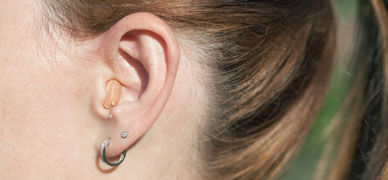
Digital hearing devices for a digital world
There are many types of hearing aids and hearing aid technologies, and today, there are digital hearing aids to complete your digitally convenient life style. They are smart and interact with other digital devices. Digital hearing aids have life-changing health benefits too, because good hearing health is linked to quality of life. They take the power of sound and your persona hearing experience to new levels, so you can feel empowered to take charge of your hearing loss.
Digital hearing aids have sound signals that vary and are individual, bringing natural sounding speech and audio enriched with depth and variation. Therefore, you can really play with the sound and volume of digital hearing aids, adjusting the experience to your personalised specifications and all your different settings.
Analogue Hearing aids on the other hand are no less than loud speakers which amplify each and every sound which comes to the patient thus creating a kind of discomfort for the user. These hearing aids do not understand any frequency division of the sound and behave the same for all frequency ranges.
Digital hearing aids use Digital Signal Processor. It reads the sound waves, processes it and amplifies it according to the hearing loss condition. Digital hearing aids can amplify or eliminate frequencies and noise patterns and even shift sounds to more comfortable ranges. They can also interact with computers, phones and many other devices and provides extensive comfortability.
Different Types of Hearing Aids
Work with an audiologist to figure out which kind of hearing aid will work best for you, as well as any special features you need. The right device for you depends on:
- The type of hearing loss you have and how severe it is
- Your age
- How well you can manage small devices
- Your lifestyle
Behind The Ear Hearing Aids (BTE)

A Behind-The-Ear Hearing Aid directly hooks over the top of the ear and rests behind the ear. The Hearing Aid rests behind the ear and a plastic acoustic tube directs amplified sound into the ear tip or customized ear mould that is fitted inside the canal. This Hearing Aid is perfect for paediatric (children) and geriatric (older adults) population.
We can suggest BTE’S to patients from Mild to Profound loss category. The best part of BTE’S is that they also come in water resistant versions and care and maintenance of a BTE is very easy.
Receiver In Canal Hearing Aids (RIC)

A Receiver in Canal hearing aids is quite smaller than BTE’S. RIC Hearing aids are placed inside the ear canal and thin electrical wires are used instead of plastic acoustic tubes. These allow low -frequency sounds to enter the ear naturally and high frequency sounds to be amplified through the hearing aid. These hearing aids quite comfortable to wear and remove. RIC hearing aids may be a good choice for mild to profound hearing loss people.
In The Ear Hearing Aids (ITE)
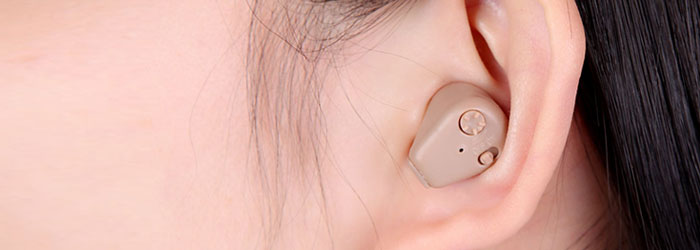
An In The Ear Hearing Aids are custom made hearing aids where the professional audiologist takes the measurement of the ear of the patients and the shell of the hearing aid is custom made to fit the patient inside the ear. These hearing Aids are suitable for minimal to moderate Hearing Loss conditions. ITE Hearing Aids have various options for manual features such as volume control, program button or telephone switch for easy usability.
The best part of any custom hearing aids is that the localisation or natural hearing can be effectively replicated due to the positioning of the hearing aid inside the canal.
In The Canal Hearing Aids (ITC)
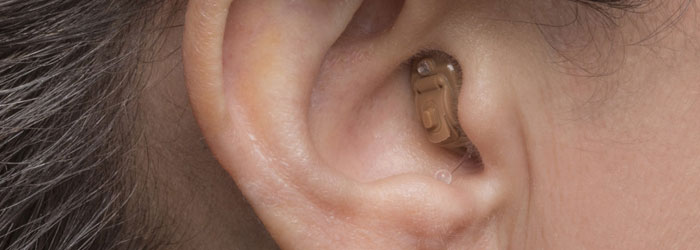
ITC hearing aids sit in the lower portion of the outer ear bowl, making them comfortable and easy to use. Because they’re slightly larger than IIC and CIC hearing aids, they tend to have a slightly longer battery life and can fit a wider range of hearing losses. Their size also allows to hosting additional features such as directional microphones for better understanding in noisy environments and manual controls, like a volume wheel, if desired. It has both wireless and telecoil option. This style is perfect for people looking for smaller size Hearing Aids with Severe Hearing Loss.
Completely In The Canal Hearing Aids (CIC)
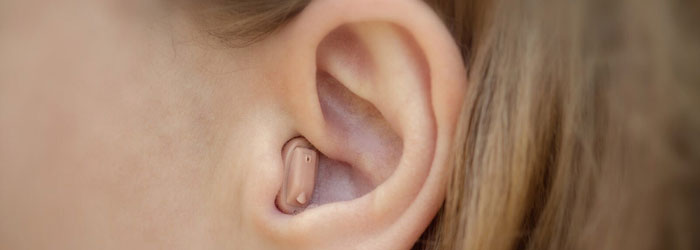
Completely In the Canal Hearing Aids fit inside the ear and out of our sight. A CIC Hearing Aid is moulded to fit inside the ear canal that improves the hearing by amplifying the sounds. CIC Hearing Aids are custom made, fits deep inside the canal and are almost invisible. It is a small and least visible type of Hearing Aid. CIC hearing aids introducing automatic features for environment detection, noise management and automatic amplification adjustment. Because of their small size, they don’t usually come with any manual controls, like volume wheels or program buttons.
Invisible In The Canal Hearing Aid (IIC)
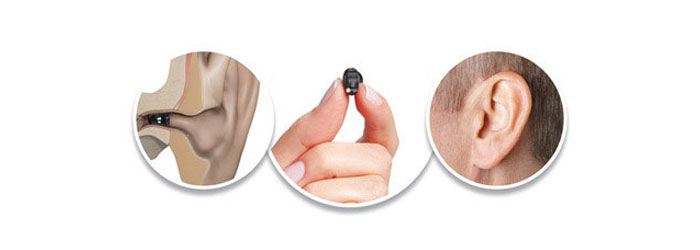
Invisible in the canal IIC hearing aids are as described—virtually invisible. A wearer places them very deeply in the ears, and they must be removed by tugging on a small pull-out string. Because of their small size, they don’t usually come with any manual controls, like volume wheels or program buttons. It has good sound quality because of how they fit within the ear.
Additional Features
Some hearing aid optional features improve your ability to hear in specific situations:
Noise reduction
reduction. All hearing aids have some amount of noise reduction available. The amount of noise reduction varies.
Directional microphones
These are aligned on the hearing aid to provide for improved pick up of sounds coming from in front of you with some reduction of sounds coming from behind or beside you. Some hearing aids are capable of focusing in one direction. Directional microphones can improve your ability to hear when you're in an environment with a lot of background noise.
Rechargeable batteries
Some hearing aids have rechargeable batteries. This can make maintenance easier for you by eliminating the need to regularly change the battery.
Telecoils
Telecoils make it easier to hear when talking on a telecoil-compatible telephone. The telecoil eliminates the sounds from your environment and only picks up the sounds from the telephone. Telecoils also pick up signals from public induction loop systems that can be found in some churches or theatres, allowing you to hear the speaker, play or movie better.
Wireless connectivity
Increasingly, hearing aids can wirelessly interface with certain Bluetooth-compatible devices, such as cell phones, music players and televisions. You may need to use an intermediary device to pick up the phone or other signal and send it to the hearing aid.
Remote controls
Some hearing aids come with a remote control, so you can adjust features without touching the hearing aid.
Direct audio input
This feature allows you to plug in to audio from a television, a computer or a music device with a cord.
Variable programming
Some hearing aids can store several preprogrammed settings for various listening needs and environments.
Environmental noise control
Some hearing aids offer noise cancellation, which helps block out background noise. Some also offer wind noise reduction.
Care and Maintenance of Hearing AidsTips for your Hearing Aids
- Avoid moisture and always store hearing aids in a dry place
- Clean the ears and remove the ear wax
- Change hearing aid batteries often
- Remove hearing aids while washing face, taking bath etc.,
- Remove hearing aids before going to bed
- Don’t place hearing aids on or nearer to electrical appliances
- Always handle with care
- Regular follow up